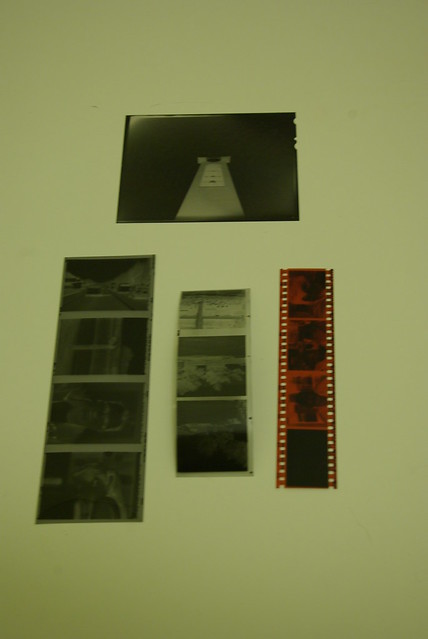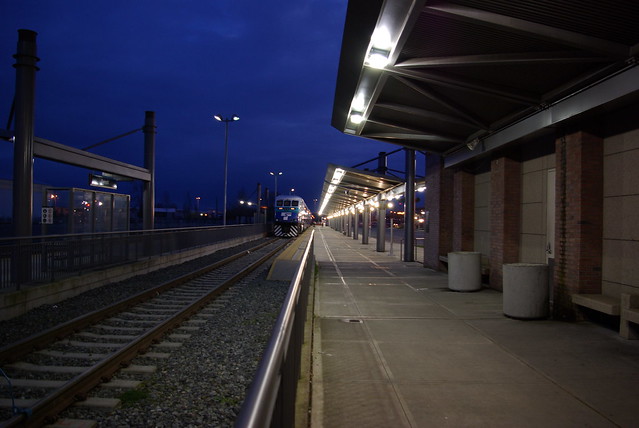I shoot film in four different formats (not including the Polaroid cameras): 35mm, 127, 120, and 4x5.
35 mm is the film you probably grew up with if you're my age (or younger). It comes in metal canisters and has notches cut into it for winding. Once a roll is shot, it is then wound back into the metal canister.
120 and 127 are very similar in every way except size. They're both paper-backed and are not in a canister. When you load these films, you first pull out the spool that was in the center of the previous roll of film and place it in the opposite end of the camera. Then you unroll the film slightly, hook it to that spool, and advance it to the 'start' mark. When you're done, you pull them out - the paper backing protects them from light, and they include a small bit of paper that you use basically like a rubber band to hold it shut. It's backed like an envelope, so you lick it and seal it.
With 35 mm, the photo size is pretty much standardized. A roll of 24 will shoot 24 shots. A roll of 36 will give you 36 shots. The exception to this is if you shoot panoramic film, which would expose the equivalent of multiple shots every time you snap the shutter - but it also winds a comparable distance to prevent double and triple exposures.
With 120 and 127 film, the number of shots per roll depends on your camera and the format it shoots. My Pentax 645n, for example, gives me negatives which are 6mm x 4.5 mm. It gives me 16 shots per roll. Pentax also made a 67, which shoots negatives which are 6 mm x 7 mm. If I remember correctly, it gives 12 shots per roll, but don't quote me on that. A number of older cameras have windows in them to show you which frame you are on. The height of these windows was standardized, and the paper backing on the film will have the numbers printed at three different heights.
120 film is still the professional standard. It's readily available at any specialty photo shop (or on Amazon). 127 film is a bit harder to find - Blue Moon has it, and that's where I get mine, but I haven't been able to find it anywhere closer. We do have some very good camera shops and labs here in Seattle, mind you, they just don't have 127 film.
4x5 sheet film is just what it sounds like - a sheet of film which is 4 inches by 5 inches. It's one shot per sheet. Every time you take a shot, you need to pull the film out of the camera and reload the camera. I've never seen any color 4x5, so I don't know if it exists or not (I suspect not).
In a few weeks, I'll get photos of some unexposed film and show you what it looks like. I'll also break out some of my forty-year-expired 120 film and show you the numbers on the back of the paper.
Today, however, I want to show you what these all look like when they've been processed, so you have an idea of how they compare, size-wise. I couldn't find any sort of comparison shot online, so I took two minutes and shot one myself. If I get a chance at some point in the future, I'll get a better shot or two.
Up top? That's obviously the 4x5 sheet. Down below, from left to right, are 120, 127, and 35 mm.

The reason the 35mm is orange is because it's color film. Color photo paper is designed to adjust for that. Color slide film processes clear like slide film, but it uses a different process that is harder to find these days. I've shot a couple rolls of color 127 film, and they're every bit as orange as the 35 mm film.
Most color film processing is C-41 process. Slide film processing is E-6 processing. You can cross-process, meaning you can put E-6 film through the C-41 process, but it does interesting things with the color. Experienced photographers know what it does - I'm not experienced enough to entirely know what to expect, but that will come with time.
There are more film formats out there. Dozens and dozens and dozens of formats - these are just the most popular formats and the only ones I'm currently shooting.
Next week, I may or may not have a post up - I just finished moving and will be in Indianapolis for a few days. There may be photos at my other blog or on my Twitter, but there won't be any actual discussion of the photos. So until I post again, keep shooting.
